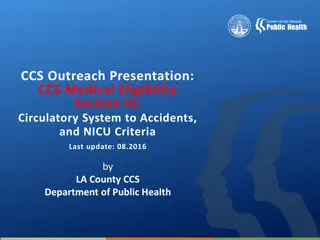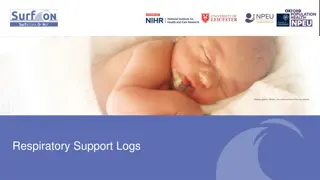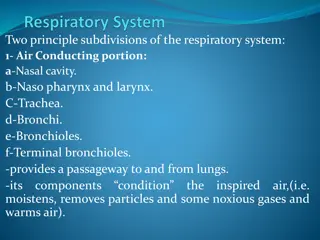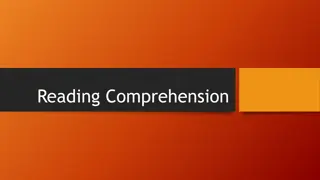The Natural History of Disease Development and Prevention
The natural history of disease development outlines the progression of a disease in an individual without intervention, from exposure to outcome. Learning objectives include defining prevention terms, understanding disease severity, prevention levels, and intervention measures. Studying disease prog
4 views • 16 slides
Comprehensive Overview of Pulmonary Function Tests (PFTs)
Pulmonary Function Tests (PFTs) are vital for assessing pulmonary gas exchange through ventilation, diffusion, and lung perfusion. These tests include measurements of lung volume, airway patency, gas exchange efficacy, and pulmonary blood flow. PFTs offer benefits in diagnosing dyspnea, monitoring d
0 views • 14 slides
Drugs Acting on the Respiratory System for Effective Treatment
Explore the classification and actions of drugs targeting the respiratory system, including antitussives, expectorants, respiratory stimulants, bronchodilators, and mucolytics. Discover how these medications work to suppress coughs, promote fluidity of bronchial secretions, and stimulate respiratory
0 views • 14 slides
Collaborating to Combat Sepsis: Role of Respiratory Therapists
Sepsis is a critical condition involving infection and inflammation, where the body's response causes widespread symptoms. Learn about the continuum of sepsis, its pathophysiology, and respiratory warning signs. Respiratory therapists play a crucial role in identifying and managing sepsis, with stat
1 views • 14 slides
Acute Respiratory Infections (ARI)
Acute Respiratory Infections (ARI), characterized by sudden onset respiratory symptoms affecting the respiratory system from nose to alveoli, are a complex group of diseases caused by various agents. Symptoms include pain in the sinuses, nasal congestion, fatigue, sinusitis, coughing, and more. The
0 views • 16 slides
The Human Respiratory System: Anatomy, Functions, and Importance
The human respiratory system plays a vital role in gas exchange and maintaining overall health. This article delves into the anatomy of the respiratory system, its main functions, such as gas exchange and air filtration, and the importance of respiratory health. Learn about the different components,
0 views • 13 slides
Chronic Obstructive Pulmonary Disease (COPD) in Horses: A Veterinarian's Perspective
Chronic Obstructive Pulmonary Disease (COPD) in horses is a respiratory condition caused by hypersensitivity reactions to allergens, viral infections, or bronchopneumonia. This chronic respiratory disease leads to decreased work performance, chronic coughing, abnormal lung sounds, and cardiac dysfun
0 views • 17 slides
Respiratory Health Insights and Updates by Dr. Zeina Aoun Bacha, MD
Explore key topics in respiratory health with Dr. Zeina Aoun Bacha, MD, including World Respiratory Diseases Day, Organizing Pneumonia, Sputnik Five Vaccine, and AstraZeneca Vaccine. Stay informed on important respiratory events and vaccination developments.
1 views • 10 slides
The Respiratory System: An Overview
The respiratory system, consisting of the upper and lower respiratory tracts, is responsible for ventilation and gas exchange. Learn about the anatomy, common symptoms like dyspnea and cough, and how the system functions anatomically and physiologically. Understanding these aspects can help in recog
0 views • 15 slides
Oxygenation and Respiratory System Function
Explore essential terms like alveoli, perfusion, atelectasis, and more in the context of respiratory system function. Learn about lung anatomy, oxygenation processes, and common respiratory disorders like dyspnea and hypoxia. Discover the crucial factors for maintaining normal respiratory function.
0 views • 35 slides
Respiratory System Disorders: Sinusitis, Rhinitis, Emphysema, and COPD
This informative content delves into common respiratory issues such as sinusitis, rhinitis, emphysema, and COPD. It provides detailed information on the symptoms, diagnostic criteria, and rating formulas for each condition. The content also touches upon military service-related respiratory problems.
0 views • 15 slides
Human Disease Symptom Network: Understanding Disease Relationships Through Symptoms and Genes
The Human Disease Symptom Network (HSDN) is constructed using a large-scale medical bibliographic records database to form a network of human diseases based on symptom similarities. By integrating disease-gene associations and protein-protein interaction data, correlations between symptom similarity
1 views • 37 slides
Medical Eligibility Criteria for Circulatory and Respiratory Diseases in CCS Outreach Presentation
This presentation outlines the medical eligibility criteria for circulatory and respiratory diseases under the California Children's Services (CCS) program. It covers conditions such as diseases of the circulatory system including endocardium, myocardium, and more, as well as respiratory conditions
0 views • 38 slides
Sniff Nasal Inspiratory Pressure (SNIP): Assessing Respiratory Muscle Strength
SNIP is a sensitive non-invasive test that measures inspiratory muscle strength by assessing nasal pressures during a sniff maneuver. It is a valuable tool for early detection of respiratory muscle decline, providing insights into potential threats like hypercapnic respiratory failure, impaired coug
0 views • 11 slides
Neonatal Respiratory Support Study Overview
This study focuses on evaluating the primary outcomes of length of hospital stay post-birth and incidence of severe respiratory failure in infants receiving respiratory support. Detailed logs are maintained daily until the infant is off respiratory support or discharged. The study is funded by NIHR.
0 views • 19 slides
Foot-and-Mouth Disease (FMD) and Bovine Viral Diarrhea (BVD)
Foot-and-mouth disease (FMD) is a highly contagious animal disease affecting cloven-hoofed animals, while Bovine Viral Diarrhea (BVD) is a serious cattle disease caused by the BVD virus. FMD is not transmissible to humans and is caused by different strains of Aphthovirus. Symptoms of FMD include ves
0 views • 12 slides
Methods of Imaging the Respiratory System
This lecture discusses various methods of imaging the respiratory system, including plain films, radionuclide imaging, CT scans, ultrasound for pleural disease, MRI, and bronchography. The normal anatomy relevant to respiratory system angiography is also highlighted through a series of images.
0 views • 27 slides
Anesthesia and Upper Respiratory Tract Infections in Children
This presentation discusses the etiology, differential diagnoses, and management of upper respiratory tract infections (URIs) in children undergoing anesthesia. It covers causes of bronchoconstriction, adverse respiratory effects of URIs, and current anesthetic recommendations. The content emphasize
0 views • 52 slides
Respiratory Care in FSHD: Guidelines and Management Overview
Comprehensive overview of respiratory care in Facioscapulohumeral Muscular Dystrophy (FSHD) based on the American Academy of Neurology guidelines. Covers incidence of respiratory insufficiency, assessment of lung function, treatment options including noninvasive ventilation, and strategies for maint
0 views • 16 slides
The Control of Breathing and Respiratory Rhythm
The content delves into the intricacies of the control of breathing, emphasizing the role of the medulla oblongata in regulating respiratory activity. It explores factors modifying breathing patterns, respiratory consequences of changing PO2, PCO2, and pH, and the functions of central and peripheral
0 views • 16 slides
The Respiratory System Components and Functions
The respiratory system consists of two primary subdivisions: the Air Conducting portion and the Respiratory portion. The Air Conducting portion includes nasal cavity, naso-pharynx, larynx, trachea, bronchi, bronchioles, and terminal bronchioles, providing a pathway to and from the lungs while condit
0 views • 12 slides
Overview of Respiratory System Components and Functions
The respiratory system consists of vital components like pulmonary compliance and surfactant, crucial for proper lung function. Pulmonary compliance reflects the lung's ease of expansion, influenced by factors like lung elasticity and surface tension. Surfactant, produced by type II alveolar cells,
0 views • 15 slides
Nasal Cavity Histology and Respiratory Structures
The detailed information provided covers the histological structures of the nasal cavity, including the vestibule, respiratory mucosa, nasal septum, olfactory mucosa, and paranasal sinuses. It also delves into the microscopic structures of the wall of the trachea and primary bronchi. The respiratory
0 views • 11 slides
Respiratory Tract Anatomy Overview
The respiratory tract anatomy includes various structures like mucosa, submucosa, and adventitia in the trachea, bronchi, bronchioles, and terminal bronchioles. Each component has specific compositions and functions, ranging from respiratory epithelium to smooth muscle layers. The images provide a v
0 views • 15 slides
Equine Influenza: An Overview of Respiratory Tract Infections in Horses
Equine influenza is a contagious upper respiratory infection in horses caused by influenza viruses. This article covers the anatomy of the equine respiratory tract, signs, diagnosis, treatment, prevention, and prognosis of equine influenza. It also discusses the histological structure of the respira
0 views • 18 slides
Innovative Technology for Diagnosing and Managing Respiratory Diseases
Monash University researchers have developed a groundbreaking non-invasive technology to diagnose and manage respiratory lung diseases, such as cystic fibrosis and lung cancer. The technology, utilizing four-dimensional X-ray velocity imaging, provides high-definition real-time images of airflow in
0 views • 4 slides
The Intriguing World of the Respiratory System
Discover fascinating facts about the respiratory system, including the anatomy of the lungs, how they help you breathe, and the interconnectedness of body systems. Learn how crucial oxygen is for sustaining life and how your respiratory organs work in tandem. Explore the essential role of the respir
0 views • 15 slides
Respiratory Rate and Ventilation in Nursing Practice
This lecture focuses on the vital signs related to respiratory rate, emphasizing the three processes of respiration: ventilation, diffusion, and perfusion. Nurses assess ventilation by observing the rate, depth, and rhythm of respiratory movement, crucial in recognizing normal thoracic and abdominal
0 views • 51 slides
Viral Infections of the Respiratory System
Respiratory viral infections are common and primarily caused by viruses, leading to morbidity and time off work. They can range from mild upper respiratory tract infections to severe lower respiratory tract infections like pneumonia. Various viruses like influenza, parainfluenza, respiratory syncyti
0 views • 23 slides
Pediatric Respiratory Infections: An Overview of Cases and Physiology
This review delves into selected cases of respiratory infections in children presented by Dr. David L. Smith, focusing on the anatomical and physiological aspects of the pediatric airway and respiratory system. It discusses respiratory failure in infants and small children, metabolic demands, cyanos
0 views • 49 slides
Alaska State Virology Lab Respiratory Virus Surveillance Program
The Alaska State Virology Lab's Respiratory Virus Surveillance Program accepts specimens from across Alaska, ranging from large hospitals to single physician clinics. They collect specimens representing CLI/ILI weekly and are interested in Severe Acute Respiratory Illness samples, among others. The
1 views • 6 slides
The Respiratory System: An Overview
The respiratory system comprises the upper and lower respiratory tracts, responsible for air movement and gas exchange. It relies on the cardiovascular system for proper blood flow. The anatomy involves structures in the upper and lower tracts, with common symptoms like dyspnea and cough indicating
0 views • 20 slides
Respiratory System Terminology and Disorders
Explore the terminology and components of the respiratory system including the upper and lower respiratory tract, respiration process, word roots, and common respiratory disorders. Learn the meanings of terms like apnoea, dyspnoea, pneumonia, and more. Enhance your knowledge of respiratory health an
0 views • 12 slides
Comprehensive Overview of Respiratory Block for Medical Students
This respiratory block introduces students to the anatomy, histology, muscles involved in respiration, embryology, radiological anatomy, and management of respiratory disorders. It covers topics like the nasal cavity, pharynx, larynx, trachea, bronchi, lungs, pleura, bronchial tree, and mediastinum.
0 views • 23 slides
The Respiratory System and Ventilation Lab Activities
Dive into the intricate workings of the respiratory system and explore various lab activities related to ventilation. From studying respiratory cycles to simulating spirometry, understanding muscle functions, exploring gas exchange in tissues, and controlling respiration, this comprehensive guide pr
0 views • 24 slides
Design of Innovative Automated Respiratory Buildings Against Coronavirus Disease
This technical report discusses the design of automated respiratory buildings to aid patients and health workers during the coronavirus disease outbreak. It explains the concept of respiration, the purpose of these systems, and the construction process. The aim is to ensure precise oxygen delivery a
0 views • 14 slides
Respiratory Physiology
The respiratory system, led by Dr. Aida Korish, facilitates gas exchange, phonation, and pulmonary defense. It also performs non-respiratory functions like regulating acid-base balance and producing surfactant. Learn about the structural organization, functions, and zones of the respiratory system i
0 views • 29 slides
Preventing Lower Respiratory Tract Infections
Lower respiratory tract infections are a common health concern, but with proper preventive measures, they can be minimized. This article discusses various strategies and practices to reduce the risk of lower respiratory tract infections, including hygiene tips, vaccination recommendations, and lifes
0 views • 28 slides
Anatomy & Physiology of the Respiratory System
The respiratory system consists of the upper respiratory tract (nose, pharynx, larynx) and lower respiratory tract. Understanding its structure and function is essential in the study of respiratory diseases like pneumonia and bronchitis. Prevention, risk factors, symptoms, and treatment options are
0 views • 82 slides
Respiratory Medicine Training in West Midlands Deanery
Welcome to the world of Respiratory Medicine in the West Midlands Deanery! This is where you'll find information on the training structure, key personnel, geographical overview, hospital specialties, and the training curriculum. Explore the diverse opportunities offered and learn about the dual accr
0 views • 26 slides







































